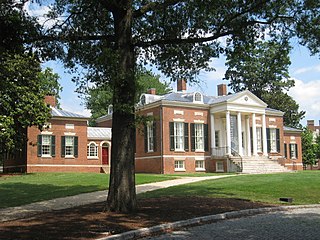
The Homewood Museum is a historical museum located on the Johns Hopkins University campus in Baltimore, Maryland. It was listed as a National Historic Landmark in 1971, noted as a family home of Maryland's Carroll family. It, along with Evergreen Museum & Library, make up the Johns Hopkins University Museums.
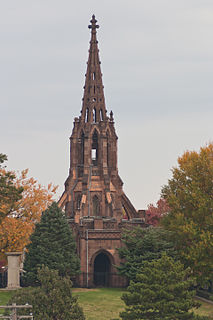
John Rudolph Niernsee was an American architect. He served as the head architect for the Baltimore and Ohio Railroad. Rudolph also largely contributed to the design and construction of the South Carolina State House located in Columbia, South Carolina. Along with his partner, James Crawford Neilson, Rudolph established the standard for professional design and construction of public works projects within Baltimore and across different states in the United States.
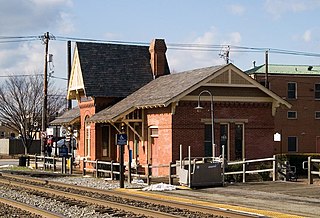
Gaithersburg station is a commuter rail station located on the Metropolitan Subdivision in downtown Gaithersburg, Maryland. It is served by the MARC Brunswick Line service; it was also served by Amtrak from 1971 to 1986. The former Baltimore and Ohio Railroad station building and freight shed, designed by Ephraim Francis Baldwin and built in 1884, are listed on the National Register of Historic Places as Gaithersburg B & O Railroad Station and Freight Shed. They are used as the Gaithersburg Community Museum.
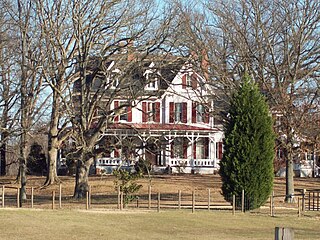
Villa DeSales, built in 1877–1878, is a large five-by-three bay, three-story frame High Victorian Gothic dwelling with a two-story south service wing, located at Aquasco, Prince George's County, Maryland. The historic home is significant for its architectural character which includes a complex of six 19th century outbuildings. This architectural style is an unusual one in Southern Maryland, an area heavily agricultural historically. The large size of the house, the decorative slate roof, amount and variety of cornice and gable trusses, brackets, and pendants; and the well preserved interior with original Gothic Revival-style lighting fixtures and parlor and bedroom furnishings make the house exceptional. In the rear yard are seven domestic and agricultural outbuildings in good condition. The stable is the only High Victorian Gothic barn or stable in Prince George's County.

The Robert Llewellyn Wright House is a historic home located at 7927 Deepwell Drive in Bethesda, Maryland. It is an 1800-square foot two-story concrete-block structure designed by architect Frank Lloyd Wright in 1953, and constructed in 1957 for his sixth child, Robert Llewellyn Wright (1903–86), who worked at the Justice Department.
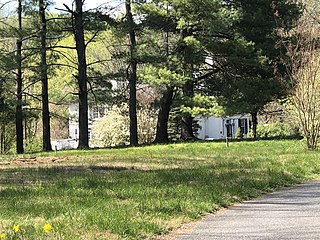
The Commodore Joshua Barney House is a historic home located at Savage, Howard County, Maryland, United States. It was originally situated on a 700-acre tract in modern Savage Maryland named Harry's Lot, at a time when the closest town was Elk Ridge. Both "Haary's Lot" and "Huntington Quarter" were inherited by Charles Greenberry Ridgely, sixth son of Colonel Henry Ridgley and Elizabeth Warfield Ridgley. After the death of Charles Greenberry Ridgely, Thomas Coale purchased portions of the land containing the structure. His daughter would become the famous Commodore Joshua Barney's second wife, bringing the figure from business in Baltimore. In 1809, Nathaniel F. Williams (1782-1864) married Caroline Barney, daughter of Joshua Barney, who in turn expanded an existing mill site on the property to create the Savage Mill.

Woodlawn, is a historic slave plantation located at Columbia, Howard County, Maryland. It is a two-story, stuccoed stone house built in 1840 with wood frame portions constructed about 1785. It was part of a 200-acre farm divided from larger parcels patented by the Dorsey family. The design reflects the transition between the Greek Revival and Italianate architecture styles. The home is associated with Henry Howard Owings, a prominent Howard County landowner and farmer, who also served as a judge of the Orphan's Court for Howard County. Owings purchased the property in 1858 and died at Woodlawn in 1869. The former tobacco farm produced corn, oats, hay, and pork. The majority of the property surrounding Woodland and its slave quarters were subdivided by 1966 and purchased by Howard Research and Development for the planned community development Columbia, Maryland, leaving only 5 acres surrounded by multiple lots intended for development of an Oakland Ridge industrial center and equestrian center. The summer kitchen, smokehouse, corn crib and stable built about 1830 have been replaced by a parking lot.
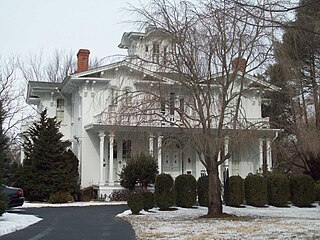
Temora, is a historic home located at Ellicott City, Howard County, Maryland. It is a T-shaped, two-story and cupola, Tuscan-style Victorian house of stuccoed tongue-and-groove boards. The house was built in 1857 after a design prepared by Nathan G. Starkweather, a little-known but accomplished architect from Oxford, England, who also designed the First Presbyterian Church and Manse at West Madison Street and Park Avenue in the Mount Vernon-Belvedere neighborhood in Baltimore, Maryland, with his later more famous assistant - Edmund G. Lind. The house was built for Dr. Arthur Pue Jr. on land given from his grandmother Mary Dorsey Pue of Belmont Estate. The name of the estate Temora comes from the poems of Ossian

The Bare Hills House is a historic home built about 1856 in the Mount Washington area of Baltimore County, Maryland, United States. It is a two-story frame dwelling with steep gables and board-and batten siding. The house is an example of the Carpenter Gothic style of architecture.

Brooklandville House, or the Valley Inn, is a historic restaurant and tavern building, and a former inn, located in Brooklandville, Baltimore County, Maryland. It is a 2+1⁄2-story stone structure facing the former railroad and dating from about 1832. It is associated with the Baltimore and Susquehanna Railroad, which crossed the property just to the south.

Hilton is a historic home located at The Community College of Baltimore County in Catonsville, Baltimore County, Maryland. It is an early-20th-century Georgian Revival–style mansion created from a stone farmhouse built about 1825, overlooking the Patapsco River valley. The reconstruction was designed by Baltimore architect Edward L. Palmer, Jr. in 1917. The main house is five bays in length, two and a half stories above a high ground floor, with a gambrel roof. The house has a 2+1⁄2-story wing, five bays in length, with a gabled roof, extending from the east end; and a two-story, one-bay west wing. The roof is covered with Vermont slate. The house features a small enclosed porch of the Tuscan order that was probably originally considered a porte cochere.
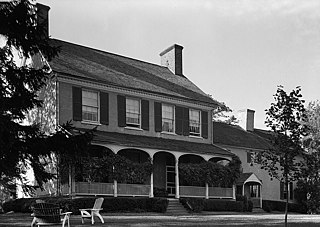
Prospect Hill is a historic home located at Long Green, Baltimore County, Maryland, United States. It was designed by architect William Thornton and built between 1796 and 1798. It is a 2+1⁄2-story Federal style brick house.
Ravenshurst, or Ravenhurst, was a historic home located at Glen Arm, Baltimore County, Maryland, United States. It was a 2+1⁄2-story Carpenter Gothic-style board-and batten house built about 1854–1857. It was an addition to an earlier stone building thought to have been built about 1800. The home burned on October 31, 1985.
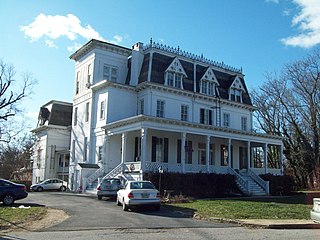
Summit is a historic home located in Catonsville, Baltimore County, Maryland. It a large brick house, once part of a country estate owned by James Albert Gary. It features a three-story Italianate tower and large wing extending to the rear. The main façade is three stories and five bays wide, with the tower located on the east side. A one-story porch with square columns and railings runs across the full façade. The mansion was built originally as a summer home and later converted to apartments after its sale to the Summit Park Company in 1919.
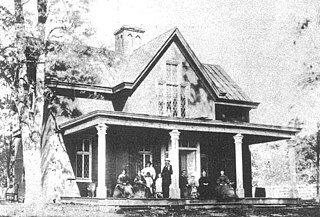
Tudor Hall is a historic home located at Bel Air, Harford County, Maryland, United States. It is a 1+1⁄2-story Gothic Revival cottage built of painted brick. The house was built as a country retreat by Junius Brutus Booth (1796–1852) from Plates 44 and 45, Design XVII, of The Architect, by William H. Ranlett, 1847. However, Booth never lived in Tudor Hall, because he died before it was completed. His son Edwin Booth lived there only briefly on his return from California before he moved the family back into Baltimore. But his other son, John Wilkes Booth, lived there with his mother, brother Joseph, and two sisters from December 1852 through most of 1856.

Olney, originally patented as Prospect, is a historic home and farm complex located at Joppa, Harford County, Maryland. It is a 264-acre (1.07 km2) working pony farm with a collection of 15 structures ranging in style, use, and elegance. The main building on the property is a 2+1⁄2-story brick house dating to 1810, generally called "the mansion." The house was evolved into a museum of Maryland architecture, with salvaged features from demolished buildings in Baltimore and Philadelphia. These include paneling from the Isaac Van Bibber house in Fells Point, Baltimore dating to 1815; the marble Ionic portico from William Small's Baltimore Athenaeum from 1830; and a marble bas-relief plaque designed by Pierre L'Enfant for Robert Morris's great 1795 house in Philadelphia. Also on the property is an early-18th-century, 2+1⁄2-story stone dwelling and a variety of still-functioning farm structures that in themselves range in style from simple stone stables and frame hay barns to an unusual two-story brick blacksmith's shop. In addition, the 1914 Union Chapel School, was moved onto the property in 1980 and re-outfitted as St. Alban's Anglican Church. The property was developed by J. Alexis Shriver (1872–1951), a man prominent in local and state historical and agricultural matters who lived at Olney from 1890 until his death.

Gallagher Mansion and Outbuilding is a historic home located at Baltimore, Maryland, United States. It was originally built about 1854 as an Italianate villa, and was subsequently enlarged and embellished in the Second Empire style of the later mid century. It features walls built of local rough fieldstone and rubble and a mansard roof covered with decorative slate. The outbuilding is a two-story rectangular wood carriage house with a hip roof and cupola.
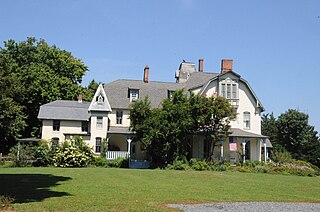
Lauretum is a historic home located at Chestertown, Kent County, Maryland, United States. It is a large, three story late Victorian stuccoed frame house built in 1881 for Chestertown lawyer Harrison W. Vickers (1845-1911). It features irregular massing, multiple roof forms, clipped gables, an oriel window, and exposed rafter ends. It was designed by Baltimore architect Edmund G. Lind (1829-1909).
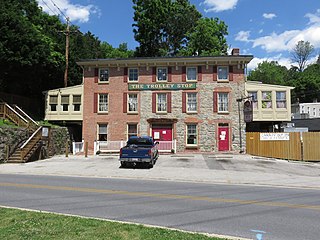
Ellicott's Mills Historic District is a national historic district at Oella, Baltimore County, Maryland, United States. It is on the east bank of the Patapsco River, opposite Ellicott City. This historic district designation relates to the industrial operations of the Ellicott family from the 1770s through the mid-19th century. It consists of the sites of historic buildings including: an 18th-century building, a section of an 18th-century mill incorporated in a 20th-century factory, a 19th-century tavern, 19th-century workers housing, and an 1859 Italianate villa built by John Ellicott. Historically, these industrious mills were served by the major east–west route in Maryland during the early 19th century, the old National Pike. Also in the district is the mammoth multi-story Wilkins-Rogers Company flour plant, which is located on the site of the 1792 Ellicott Flour Mill, the first merchant flour mill in the United States.
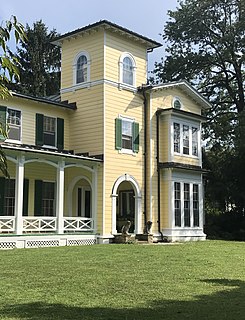
The Anneslie Historic District encompasses a residential area just north of the city line of Baltimore, Maryland in Towson. It is a grid of five streets extending eastward from York Avenue and south from Regester Avenue. The area was platted out in 1922 and mostly built out by the 1950s. Properties in the northern section of the district, on Regester Avenue, Murdock, Anneslie, and Dunkirk Roads, were built in the 1920s and 1930s, in Bungalow, Foursquare, and cottage styles, while the streets further south were built out primarily with Cape, Tudor, and Colonial style houses. The district takes its name from Anneslie estate, whose house still stands in the district.























